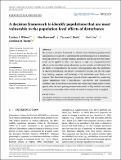A decision framework to identify populations that are most vulnerable to the population level effects of disturbance
Abstract
We present a decision framework to identify when detailed population-level assessments are required to understand the potential impacts of a disturbance-inducing activity on a marine mammal population and discuss how the framework can be applied to other taxa. Species at high risk of population-level effects can be identified using information on the number of individuals that are likely to be disturbed by the activity, total population size, the probability of repeated disturbance, the species’ reproductive strategy, and the life stages (e.g., feeding, pregnant, lactating) of the individuals most likely to be exposed. This hierarchical approach provides those responsible for conducting impact assessments with a time-efficient, cost-effective and reproducible workflow that allows them to prioritise their efforts and assign funds to those species with the most pressing conservation needs. A fully worked case study using marine mammals in the vicinity of a naval training activity is supplied.
Citation
Wilson , L J , Harwood , J , Booth , C G , Joy , R & Harris , C M 2020 , ' A decision framework to identify populations that are most vulnerable to the population level effects of disturbance ' , Conservation Science and Practice , vol. 2 , no. 2 , e149 . https://doi.org/10.1111/csp2.149
Publication
Conservation Science and Practice
Status
Peer reviewed
ISSN
2578-4854Type
Journal article
Description
This study was supported by Office of Naval Research grant N00014-16-1-2858: “PCoD+: Developing widely-applicable models of the population consequences of disturbance.”Collections
Items in the St Andrews Research Repository are protected by copyright, with all rights reserved, unless otherwise indicated.

